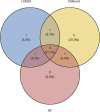Preoperative Albumin to Alkaline Phosphatase Ratio and Inflammatory Burden Index for Rectal Cancer Prognostic Nomogram-Construction: Based on Multiple Machine Learning
- PMID: 39713712
- PMCID: PMC11662910
- DOI: 10.2147/JIR.S500900
Preoperative Albumin to Alkaline Phosphatase Ratio and Inflammatory Burden Index for Rectal Cancer Prognostic Nomogram-Construction: Based on Multiple Machine Learning
Abstract
Purpose: Preoperative albumin to alkaline phosphatase ratio (AAPR) and inflammatory burden index (IBI) are prognostic indicators for a multitude of cancers, and our study focuses on evaluating the prognostic significance of the AAPR and the IBI on rectal cancer (RC) patients to provide a more accurate guideline for patient prognosis.
Patients and methods: This study enrolled patients who underwent laparoscopic rectal cancer surgery from January 2016 to January 2021. We utilized three machine learning approaches to select variables most relevant to prognosis in the training cohort. Finally, based on the screened variables, a nomogram was established to predict RC patients' overall survival (OS). The improvement in predictive ability and clinical benefit was assessed through the concordance index (C-index), receiver operating characteristic (ROC), calibration curve, and decision curve analysis (DCA).
Results: A total of 356 patients were enrolled and they were randomly divided into a training cohort (60%, n=214) and a validation cohort (40%, n=143). Overall survival (OS) was worse for patients in either the low AAPR or the high AAPR group, whereas patients in the low AAPR with both high IBI group had the lowest OS (P<0.001). Finally, five variables were obtained after screening the best variables by three machine learning, and the nomogram was constructed. In both the development and validation cohorts, the C-index values exceeded 0.85, indicating that the predictive model has a strong predictive performance in terms of overall survival. The calibration curves and the decision curve analysis (DCA) showed that the nomogram demonstrated a superior benefit.
Conclusion: Preoperative AAPR and IBI can serve as effective indicators for predicting the OS of RC patients. We have developed a nomogram for predicting the OS of patients who underwent laparoscopic rectal cancer surgery.
Keywords: albumin to alkaline phosphatase ratio; inflammatory burden index; overall survival; prediction nomogram; rectal cancer.
© 2024 Li et al.
Conflict of interest statement
The authors report no conflicts of interest in this work.
Figures








Similar articles
-
Prognostic value of albumin-to-alkaline phosphatase ratio and CONUT score in rectal cancer patients undergoing XELOX-based chemotherapy: development of a nomogram-based predictive model.Am J Cancer Res. 2025 Apr 15;15(4):1578-1596. doi: 10.62347/HSDE2538. eCollection 2025. Am J Cancer Res. 2025. PMID: 40371163 Free PMC article.
-
Albumin-to-Alkaline Phosphatase Ratio is an Independent Prognostic Indicator in Combined Hepatocellular and Cholangiocarcinoma.J Cancer. 2020 Jun 29;11(17):5177-5186. doi: 10.7150/jca.45633. eCollection 2020. J Cancer. 2020. PMID: 32742464 Free PMC article.
-
Construction and Validation of a Serum Albumin-to-Alkaline Phosphatase Ratio-Based Nomogram for Predicting Pathological Complete Response in Breast Cancer.Front Oncol. 2021 Oct 8;11:681905. doi: 10.3389/fonc.2021.681905. eCollection 2021. Front Oncol. 2021. PMID: 34692474 Free PMC article.
-
Development and validation of a nomogram prediction model based on albumin-to-alkaline phosphatase ratio for predicting the prognosis of gallbladder carcinoma.Pathol Oncol Res. 2023 Jan 4;28:1610818. doi: 10.3389/pore.2022.1610818. eCollection 2022. Pathol Oncol Res. 2023. PMID: 36685104 Free PMC article.
-
Prognostic Value of a Nomogram Based on the Dynamic Albumin-to-Alkaline Phosphatase Ratio for Patients with Extensive-Stage Small-Cell Lung Cancer.Onco Targets Ther. 2020 Sep 11;13:9043-9057. doi: 10.2147/OTT.S262084. eCollection 2020. Onco Targets Ther. 2020. PMID: 32982294 Free PMC article.
Cited by
-
Machine Learning-Assisted Analysis of the Oral Cancer Immune Microenvironment: From Single-Cell Level to Prognostic Model Construction.J Cell Mol Med. 2025 Jun;29(11):e70637. doi: 10.1111/jcmm.70637. J Cell Mol Med. 2025. PMID: 40457149 Free PMC article.
-
Association and Predictive Ability between Inflammatory Burden Index and Fever Following Endobronchial Forceps Biopsy in Lung Cancer Patients.J Inflamm Res. 2025 May 2;18:5911-5922. doi: 10.2147/JIR.S521144. eCollection 2025. J Inflamm Res. 2025. PMID: 40331157 Free PMC article.
-
Prognostic value of albumin-to-alkaline phosphatase ratio and CONUT score in rectal cancer patients undergoing XELOX-based chemotherapy: development of a nomogram-based predictive model.Am J Cancer Res. 2025 Apr 15;15(4):1578-1596. doi: 10.62347/HSDE2538. eCollection 2025. Am J Cancer Res. 2025. PMID: 40371163 Free PMC article.
References
LinkOut - more resources
Full Text Sources

